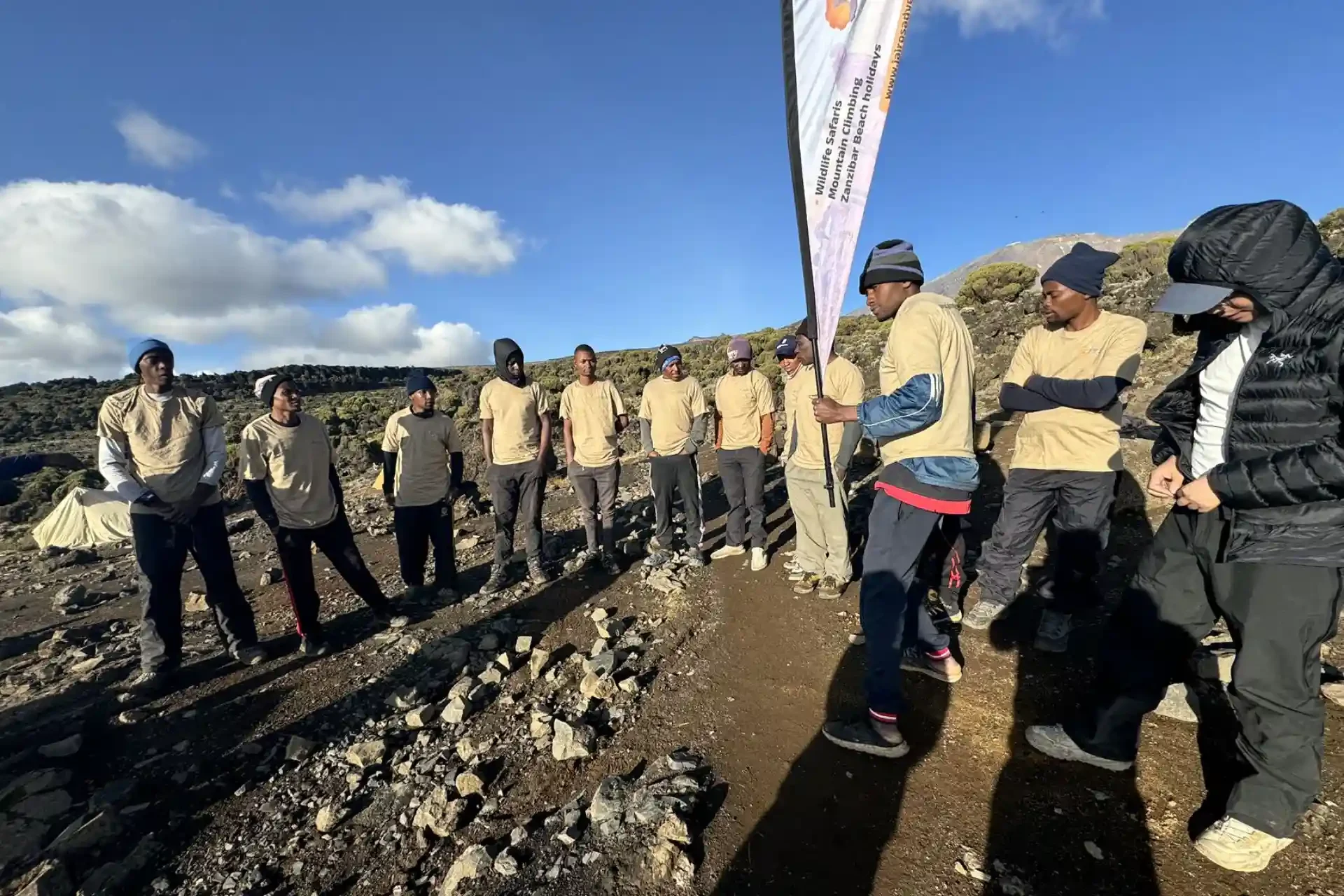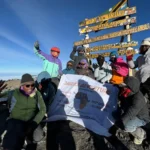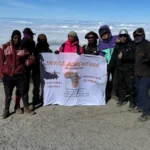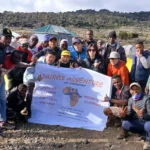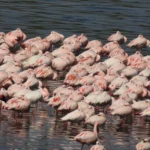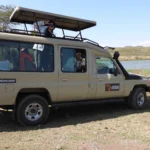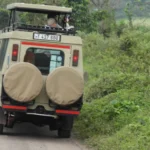UBWE ROUTE KILIMANJARO
Umbwe route is one of the shortest routes to the Southern Glaciers and the Western Breach and is considered the hardest and challenging route on Mount Kilimanjaro. The rapid speed of the ascent and steepness makes acclimatization very difficult. The Umbwe Route is the trail for trekkers looking for a true climbing challenge. It is a quiet, seldom used path that can be very difficult, yet very rewarding at the same time. This is the route to choose if you want to test yourself on the slopes of Mount Kilimanjaro, far from the crowds that are found on the more common trails.
While Umbwe route is a non-technical climb, it does offer steep ascents and requires trekkers to scramble over rocks and tree roots at certain points. It is known to be the hardest and most direct route up the Kilimanjaro and even features several exposed ridges that are not for the faint of heart. The fitness and stamina of hikers may be tested along the way and it is best for experienced mountain trekkers who are looking for a challenge. Because of it’s steep, direct approach, the success rate on Umbwe route is lower than some of the other routes. To get the most out of this climb, trekkers are encouraged to be as fit and ready as possible, as this is a steady march uphill for the first few days, which is contrast to some of the other routes that make slow, steady ascents or wander up and down to aid in acclimatization. That said, the intense challenge of trekking the Umbwe Route is made up for by the spectacular views. At times, there are stunning vistas to be seen to both the left and the right as trekkers as they make their way up the trail.
That said, the intense challenge of trekking the Umbwe Route is made up for by the spectacular views. At times, there are stunning vistas to be seen to both the left and the right as trekkers as they make their way up the trail. In fact, the early days of this path have arguably the best views of any part of the mountain, save perhaps the summit itself. Umbwe also happens to be one of the quietest routes up Mount Kilimanjaro too. Because of its reputation as a difficult climb, very few people actually walk this trail, leaving it open and relatively untouched.
This helps to give trekkers the feeling that they are the only ones on the mountain until the route merges with Machame route near the Barranco Camp a few days into the hike. From there, it follows the familiar Southern Circuit below the Southern Ice Field before turning up towards the summit from Barafu Camp. As with most Kilimanjaro climbs, the descent is made along the Mweka Route. If you’re looking for the absolutely best views on the way up Mount Kilimanjaro, and you enjoy testing yourself in the wilderness, Umbwe route will provide you with everything you seek, and then some. It is the closest thing you’ll find to a true mountaineering expedition on Kilimanjaro. We offers Umbwe as a 6 or 7 day group or private climb. The seven day variation adds an acclimatization day on day 3 at Barranco Camp.
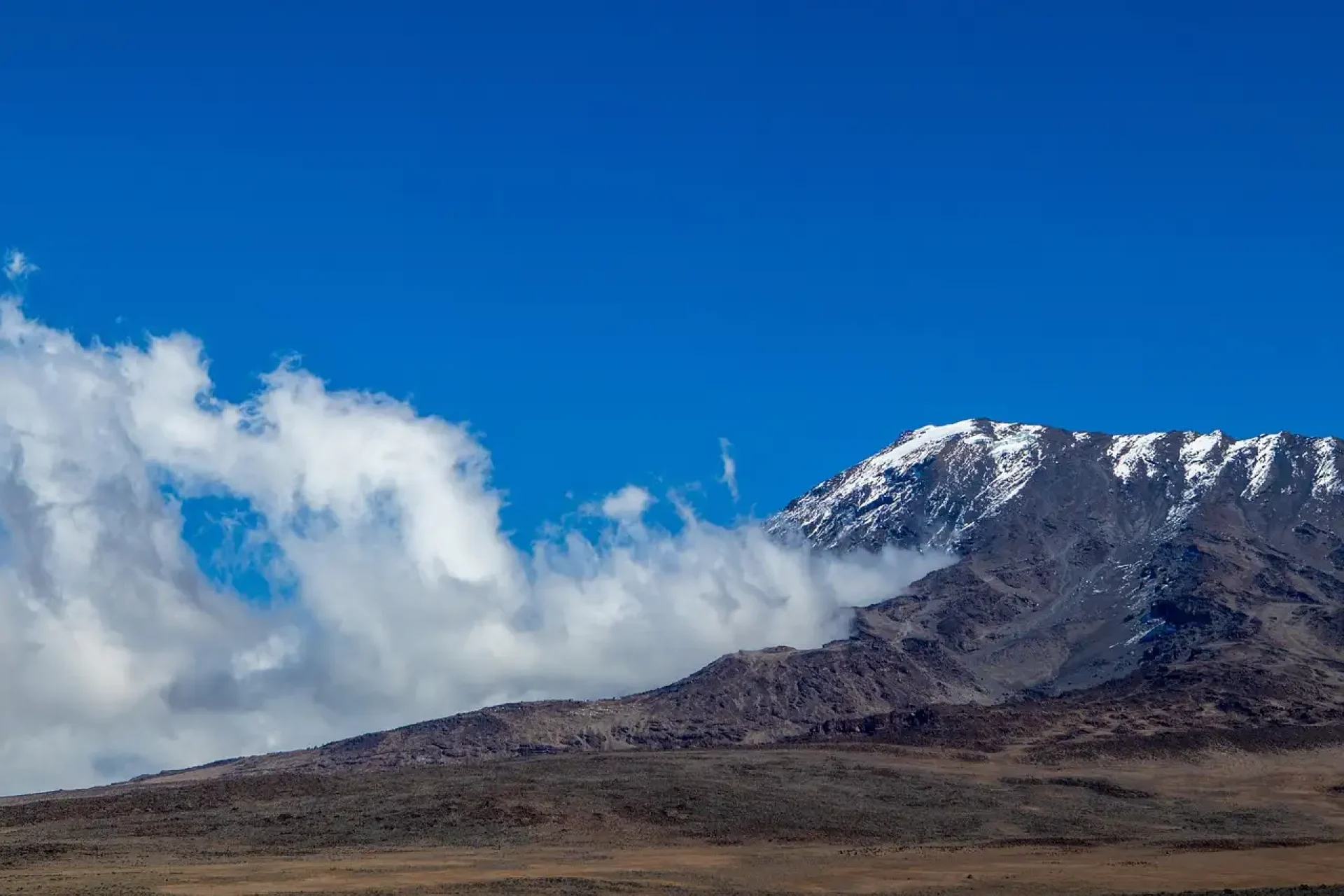
Ubwe Route
Umbwe route is a less popular trail that deserves attention. In the past, it was perceived as a difficult route. However, while it is steeper in the first two days, the route is still suitable for many hikers. It begins on the southern side of Mount Kilimanjaro, converging with Lemosho route and Machame route on the third day before the Barranco Wall. A key characteristic of Umbwe is that during the first two days you will hardly see other trekkers. It’s available in 6 or 7-day itineraries, with the seven-day option being the recommended one for beginners without prior acclimatization. Overall, it’s a very scenic route that will allow you to see some of the best views on Kilimanjaro, traverse all of the mountain’s climatic zones, and observe its unique plants and animals.
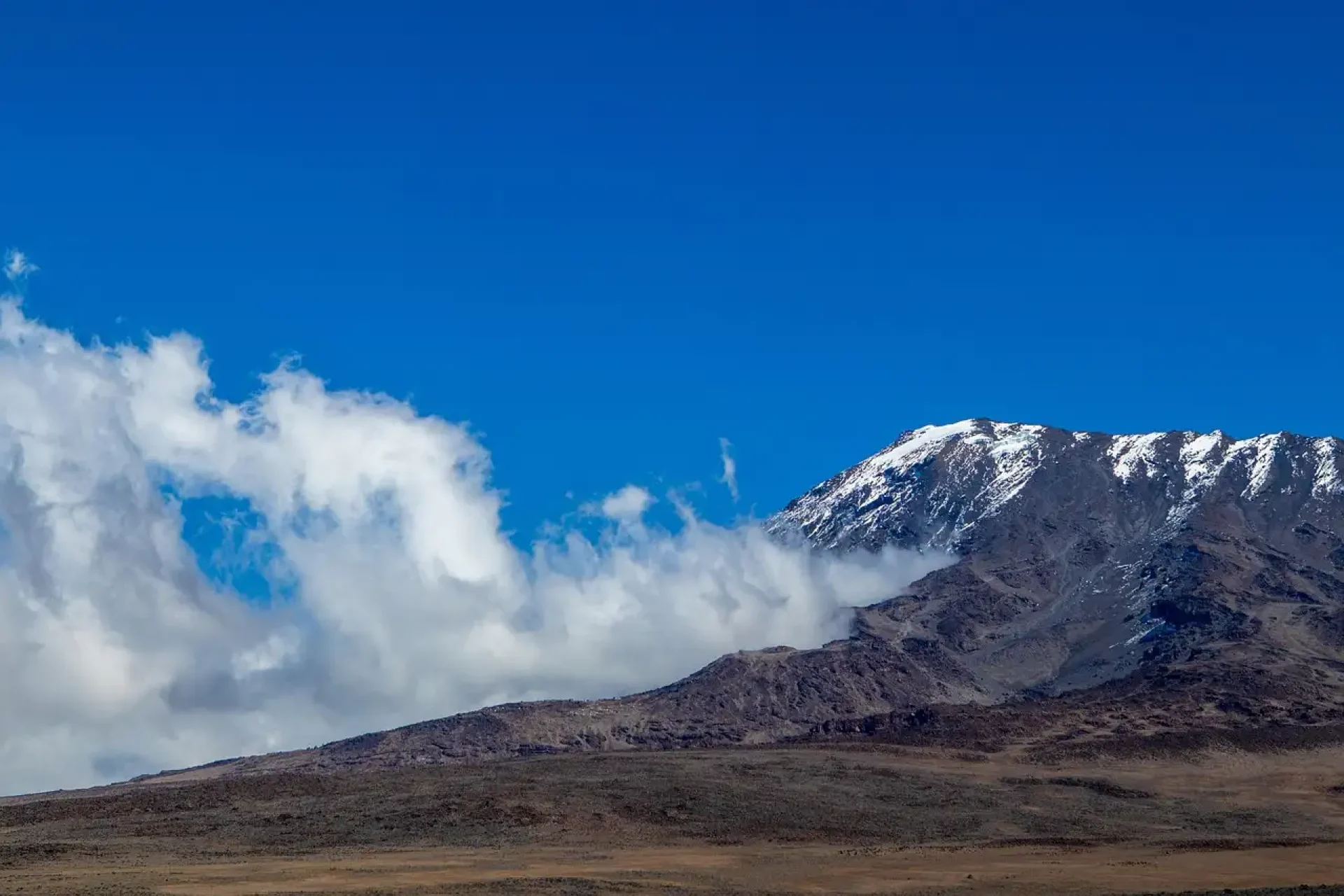
6 Day Ubwe route
The Umbwe Route is steeper and shorter than the Machame Route. Once at the Barranco Hut you continue on with the other Machame hikers. The descent is down the Mweka trail.
FAQ
How difficult is the Umbwe Route?
The Umbwe route is one of the shortest routes to the Southern Glaciers and the Western Breach and its the most challenging route on Mt Kilimanjaro. Approaching from the south, the Umbwe route is a short, steep and direct climb. It is probably the most scenic, non-technical route on Kilimanjaro. It is quite taxing, primarily due to the relatively fast ascent to higher altitude, but the rewards are plentiful.
Due to the fast ascension to high altitude, this route does not provide the necessary stages for acclimatization. Although the traffic on this route is very low, the chances of success are also low. Good level of fitness is highly recommended.
What is the distance of the Umbwe Route and how many days does it take?
The exact trekking distance for the Umber Route is 53km or 32 miles. The shortest number of days required for the Umbwe Route is 5 days, It’s a Shorter ascents with strenuous trekking days. By the time you have added on arrival and departure days it is 9 or 10. However, as it’s considered one of the Shortest and steepest routes on the mountain it is strongly recommended to be very well prepared and acclimatized to increase your chances of success.
What is the Umbwe Route Summit Success Rate?
The Umbwe Route is one of the Shortest routes up Kilimanjaro which has a very poor chance for acclimatization due to it’s steepness and days spend in the mountain. Whilst there are no official statistics, the average success rate across all operators is 70%. However, We have a summit success rate of over 90% for the Umbwe Route!
What is the Scenery like on the Umbwe Route?
The first two days of the Umbwe Route trek are through tree plantations and then beautiful and rich rain forest, before continuing into the steep Western Breach and Arrow’s Glacier path, scramble up to the Reutsch Crater (5,800 meters) where trekkers spend the night near one of Kilimanjaro’s last remaining glaciers, Furtwangler Glacier.
From Crater Camp, one can take an optional one hour hike to Reusch Crater, or simply explore the areas around Furtwangler Glacier. Reusch Crater is a magnificent sight. It is almost perfectly circular and the ash pit measures 400 feet (120 m) deep and 1,300 feet (400 m) wide. This is rarely seen by tourists.
When is the best time to Trek Umbwe Route?
July-September is the best time to trek the Umbwe Route, as the weather is most stable during this period and encountering rain is less likely. That said, since it is close to the equator it is possible to climb the mountain at any time of the year. April and May is the rainy season so this period is best avoided.
FAQ
Lemosho 7 days vs Lemosho 8 days
You might wonder which Lemosho itinerary is more suitable for your expedition: the 7-day or 8-day variation. The 7-day itinerary begins at 3,414m, jump-starting your acclimatization. This way, you can benefit from more days on the altitude, yet this rapid altitude gain might be uncomfortable for some hikers. In addition, the first two days of this itinerary are fairly easy hikes with not much altitude gain.
In contrast, the 8-day route starts at 2,100m and features a more challenging first day. However, starting lower, you’ll get to experience a more gradual acclimatization and enjoy hiking through a rainforest. Overall, both routes are highly recommended for climbers of all levels. They offer great acclimatization profiles, summit success rates of well over 90%, and rank among the most scenic routes on Kilimanjaro.
Lemosho 8 day’s vs Northern Circuit
The Lemosho 8 route is beautifully scenic and it also has a good acclimatization profile like in the case of Northern Circuit 8. However, the Northern Circuit offers views of Kilimanjaro from all four directions but it is relatively less attractive. This is because the northern aspect is less rain-fed and therefore has less and less varied flora. Also worth noting is that even though the Lemosho has a better summit success rate, it is almost within the top three most crowded routes on Kilimanjaro, the Northern Circuit is less crowded.
Considering the distance, the Northern Circuit is a more appropriate option for hikers who are in good shape and consider long treks on a daily basis as a matter of fact. Also, if you really do not wish to face the Barranco Wall, Northern Circuit has that option. Both the circuits can be undertaken with no need for any technical training nor physical preparations and are well fitting for acclimatization. The summit success rate is higher on Lemosho mostly because few hikers on this route take the long way round of the Northern Circuit and get worn out.
How many miles in the Lemosho Route
The 8-day Lemosho route itinerary spans approximately 70 km (43 miles), while the 6 and 7-day variations cover around 56 km (35 miles). This puts Lemosho somewhere in the middle, if we look at the length of other Kilimanjaro routes.
Where does the Lemosho route start?
The 8-day variation begins at Londorossi Gate (2250m), whereas the 6-7 day options commence with a vehicle drop-off at 3,414m on the Shira Plateau.
Does Lemosho go via the Barranco Wall?
Yes, the Lemosho route goes via the Barranco Wall. Yet, its appearance can be more daunting than the actual experience. Even many seniors have successfully navigated it without significant difficulty! For more information check out our guide on the Barranco Wall.
How hard is the Lemosho Route compared to other routes?
The climb is moderately challenging, but it’s well within reach for the average person in decent shape. Remarkably, it stands out as the top choice for beginners, boasting the highest success rates.
How difficult is the lemosho Route?
The Lemosho route is considered one of the easiest routes on Kilimanjaro as it’s longer itinerary allows for better acclimatization. However, hikers will still need to ascend the Barranco Wall and climb steeply on summit night. No technical climbing is required but a good level of fitness is highly recommended. You can read more on training to climb Kilimanjaro and our Kilimanjaro training program page to help you prepare accordingly.
What is the distance of the Lemosho Route and how many days does it take?
The exact trekking distance for the Lemosho Route is 71km or 43 miles. The shortest number of days required for Lemosho Route is 7 days, but by the time you have added on arrival and departure days it is 10. However, as it is a much longer approach route it is actually best done over 8 or 9 days to increase your changes of success.
The Complete Kilimanjaro Packing List
In order to be safe and comfortable throughout your Mount Kilimanjaro climb, you’ll need to bring important gear and supplies with you. We have put together a comprehensive Kilimanjaro Packing list to help you prepare for your climb. Trekking Kilimanjaro involves five main climate zones, from the warm, humid forest and lower slopes, to the bitterly cold summit zone, with glaciers, ice, and snow. You need to be prepared for all Kilimanjaro weather conditions: sunny, windy, and rainy.
We provide tents, the camp equipment, food, cooking facilities, and other shared items. You’ll have a duffel bag with all your kit, carried by the porters; and carry your own daypack during the trekking day.
Download your printable Kilimanjaro packing checklist here
Climbing Kilimanjaro Information
It is absolutely vital that one stays well-fed during the climb particularly at times like this when the conditions do not make one want to eat or drink as much as they should. Because so many climbers face loss of appetite during altitudes, our head chef has devised special menu plans that are appetizing, healthy, and loaded with juices of energy necessary to get to the top. Meals, by default, have fresh fruits and vegetables every day. Fresh meat will be there at the beginning of the trek and on the southern route where it is possible; we resupply the team at Karanga Camp. As an extra treat after your summit ascent, we will be ready to have an “All Day Breakfast” when you return to Base Camp – just inform our cook how you’d like your eggs! And before you leave the mountain, you also get to sample some of the local Tanzanian cuisine such as Njegere and Machalari.
Food & drink
The entire day-by-day itinerary includes everything from hotel accommodation to meal basis. All pre-and-post climbing accommodation is in Moshi. We will have booked you a hotel in Arusha upon your arrival if you decide to go on safari before your climb so that your travel time gets shortened. Where you have a B&B basis, you could either purchase snacks or meals in the hotel, which can be paid in Tanzanian Shillings or many times in US Dollars. When you arrive at the hotel, take time to familiarize yourself with the layout and the procedures in case of fire, especially with your escape routes and fire exits.
Your meals will be taken in a separate mess tent where you will be able to sit comfortably, while you relax and chat with your teammates and enjoy the wholesome food that our cook has freshly prepared for you. Inside, you’ll be pleased to find a table (of course) and a proper, comfortable chair with arms. With a full 2 mmetersof headroom, even the tallest climbers will be able to stretch a bit and move about without hunching over. They are fully waterproof, and regularly withstand the worst weather Kilimanjaro has to offer. A toilet tent is provided with toilet paper.
We use only the very finest high-altitude mountain tents, Mountain Hardwear Trango 3, to ensure you stay warm, dry, and comfortable on your climb up Kilimanjaro. Keep in mind that these are mountain tents and are made for extreme conditions, so don’t expect to be walking around standing inside! The dry and dusty conditions we experience in Kilimanjaro create havoc on the zips and easily jam them. Our guides are armed with WD-40 so just ask them for assistance rather than trying to force the zip.
Accommodation
The entire day-by-day itinerary includes everything from hotel accommodation to meal basis. All pre-and-post climbing accommodation is in Moshi. We will have booked you a hotel in Arusha upon your arrival if you decide to go on safari before your climb so that your travel time gets shortened. Where you have a B&B basis, you could either purchase snacks or meals in the hotel, which can be paid in Tanzanian Shillings or many times in US Dollars. When you arrive at the hotel, take time to familiarize yourself with the layout and the procedures in case of fire, especially with your escape routes and fire exits.
Transport
Kilimanjaro National Park operates a strict limit of 20kg per porter in respect of carrying your main equipment bag. This limit also applies to your sleeping bag, even if rented from us. This is more than enough for your use while in the mountain. Your bag will be weighed before you leave the hotel to start the climb and if it is in excess you will have to take things out and leave them at the hotel. Additional porters can easily be hired but they cost $25 per day.
Luggage - Weight of Climbing Bags
This is a complete ban on all single-use plastic bags in Tanzania as of 1st June 2019. Join us in this fight against plastic by using more sustainable alternatives while coming down with your bag like packing cubes and dry bags. Passengers with carry-on luggage that include plastic bags may be required to surrender on arrival at the airport. The zip-lock bags used to carry liquids and toiletries in cabin baggage on airplanes will still be allowed, however.
Ban on Plastic Bags
Usually, climbers wanting to take on Kilimanjaro will fly to Kilimanjaro International Airport (JRO), and KLM offers a perfect flight from all the major UK airports, milling around many of the larger US international airports. However, in the UK flights leave for JRO early morning only, switching at Luchthaven Schiphol, Amsterdam’s main air hub, and arriving at JRO late that same evening.
Tradition has it that one starts all adventures on the majestic Mount Kilimanjaro from a town called Moshi. Moshi lies along the low slopes of Mount Kilimanjaro on the southern side at nearly an altitude of 1000 meters over sea level. It is only about 40 kilometers by road from Kilimanjaro International Airport and transport from there to your hotel is part of your trek. Therefore, travel is almost any time of the day or night and lasts approximately 45 minutes.
Another hotel option because it is Moshi; Moshi, however fills up quite fast during peak season and should be booked with us as early as possible. It is always wise to schedule an extra day to rest after a long flight to recharge you and your gear before going on the trek rather than starting early the next morning after your arrival.
Some climbers from the United Kingdom prefer flying into Nairobi through either Kenyan Airways or British Airways. These flights are only accessible and originate from Heathrow in London. When most climbers reach the Nairobi airport, they will usually book another flight to Kilimanjaro International Airport through Precision Air, Air Kenya, Air Tanzania, or even Ethiopian Airways.
Actually, we do not recommend flying through Nairobi because Nairobi Airport always proves to be very uncomfortable and, at times, the transfer times can be really long. It also has the tendency of being poor in baggage handling and delays in transferring luggage between flights.
Turkish Airlines, Air Emirates, and Qatar also fly into JRO now, but these flights often involve long delays and flights leaving late at night for UK travelers. However, climbers from the US usually report better service and experiences flying Turkish Airlines, Air Emirates, and Qatar, so we do recommend these flights departing from North America.
Vayama offers really good flights to East Africa, like Tanzania, Uganda, Kenya, or Zanzibar from JRO, and is a very good option if you want to spend some time in this lovely area before heading back home. Many travelers plan a holiday on the beach in exotic Zanzibar to relax after their climb. We believe that the best way to organize transport for that is by booking your return flight from Dar Es Salaam and then to Zanzibar on an internal flight, ultimately back to Dar Es Salaam for your flight home.
If you are changing or re-checking an airline at any airport on route, always leave a minimum of 3 hours between flights. This accounts for any delays on arrival, travel time across airports (this can often take longer than expected), and time to re-check baggage.
How do I get there?
At Jairos Adventures, we believe in helping our guests to make their travels greener. By 2025, all our travels will be carbon-neutral from the time our guests arrive in destination until the time we drop them off at the airport. Since we do not include flight travel in our trips, we are not including them in our offset calculations, so here is the calculator below for you to use for that purpose yourself.
Travelling Responsibly
Please read a little of our Kilimanjaro Training Guide without constraint and at whatever pace you find comfortable since it is full of important advice on how to physically prepare yourself for the climb.
Fitness and training
The Tanzanian Shilling is an isolated currency meaning that you will not be able to purchase it before you arrive. It is better if you travel with US Dollars as these are broadly acceptable. The US bills must be new (not older than 10 years), crisp, and not out-turn. If you want some local currency to buy snacks or drinks either at your hotel or on your way to the climb, we can organize and take you to an ATM or bank. Moreover, there is a currency exchange as you walk through the Baggage Collection area of the airport. However, if you want to rely on a credit or debit card for emergency funds, do not forget to tell your card issuer that you will be using it abroad, or you may find that it won’t work when you really need it.
Please keep in mind that not all hotels accept card payment, and you may need to withdraw cash from an ATM.
Budget & change
We Work with Kilimanjaro Porters Assistance Project. They recommend the following momentous tipping procedure. Just to give you some guideline figures, KPAP recommended tips for porters are 6-10 dollars per day per porter. For the other roles, we recommend $20 per day for guides, $12-15 per day for assistant guides, and $12-15 per day for cooks. This is for groups and not per climber. You will receive a copy of the recommendations as well as the estimated crew numbers for your group. Size can only be known on that day during the first day of the climb after weighing bags and equipment at the park gate. First camp will tell you the final number of crew and the position they will be on climb.
You might find it useful to know that some of the porters join the group for support during your summit attempt. This is another job the porters do to give you the best possible chance at reaching the summit. Please tip them directly for any assistance you receive. An extra tip of $20 would be our recommendation.
The last evening at the mountain will also serve as the great tipping event, where all the crew will celebrate with you. A representative from your group should say a few words of thanks, which will then be translated into Kiswahili by the lead guide.
Due to recent cases of theft on Kilimanjaro, we no longer recommend that clients carry cash with them during the climb, and so the actual tip money will be presented to you when you return to the hotel. Your group will each be supplied with a couple of envelopes in which tips can be put; there will be one envelope to be used for porters, and one separate envelope that you will be using to tip your lead guide, assistant guides and cook. A trip of three porter representatives will come to the hotel and receive the tip envelope on behalf of all porters and distribute the money themselves.

